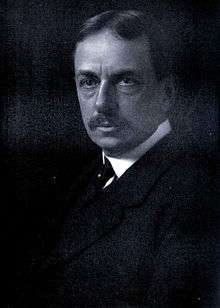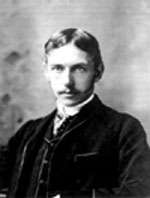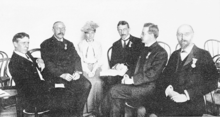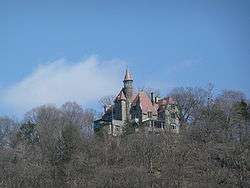Henry Fairfield Osborn
Henry Fairfield Osborn, Sr. ForMemRS[1] (August 8, 1857 – November 6, 1935)[2] was an American paleontologist, geologist and eugenics advocate. He was the president of the American Museum of Natural History for 25 years.
Henry Fairfield Osborn ForMemRS | |
|---|---|
 Photo from 1919 | |
| Born | August 8, 1857 |
| Died | November 6, 1935 (aged 78) |
| Citizenship | American |
| Alma mater | Princeton University |
| Spouse(s) | Lucretia Thatcher Perry
( m. 1881; died 1930) |
| Children | Henry Fairfield Osborn, Jr. |
| Awards |
|
| Scientific career | |
| Fields | |
| Institutions | American Museum of Natural History |
| Doctoral students | William King Gregory |
Early life and education

Henry Fairfield Osborn was born in Fairfield, Connecticut on August 8, 1857. He was the eldest son of prominent railroad tycoon William Henry Osborn and his wife, Virginia Reed (née Sturges) Osborn.[3] His younger brother was William Church Osborn,[4] who served as president of the Metropolitan Museum of Art,[5] and married philanthropist and social reformer Alice Clinton Hoadley Dodge, a daughter of William E. Dodge Jr.[6]
His maternal grandparents were Jonathan Sturges, a prominent New York businessman and arts patron who was a direct descendant of Jonathan Sturges, a U.S. Representative from Connecticut, and Mary Pemberton Cady, a direct descendant of prominent educator Ebenezer Pemberton.[7] His maternal aunt Amelia Sturges, was the first wife of J. P. Morgan, but died of tuberculosis soon after their wedding.[8]
From 1873 to 1877, Osborn studied at Princeton University, obtaining a B.A. in geology and archaeology, where he was mentored by paleontologist Edward Drinker Cope. Two years later, Osborn took a special course of study in anatomy in the College of Physicians and Surgeons and Bellevue Medical School of New York under Dr. William H. Welch, and subsequently studied embryology and comparative anatomy under Thomas Huxley as well as Francis Maitland Balfour at Cambridge University, England.[9][10]
In 1880, Osborn obtained a Sc.D. in paleontology from Princeton, becoming a lecturer in Biology and Professor of Comparative Anatomy from the same university between 1883 and 1890.
Career
In 1891, Osborn was hired by Columbia University as a professor of zoology; simultaneously, he accepted a position at the American Museum of Natural History, New York, where he served as the curator of a newly formed Department of Vertebrate Paleontology. As a curator, he assembled a remarkable team of fossil hunters and preparators, including William King Gregory; Roy Chapman Andrews, a possible inspiration for the creation of the fictional archeologist Indiana Jones; and Charles R. Knight, who made murals of dinosaurs in their habitats and sculptures of the living creatures. On November 23, 1897 he was elected member of the Boone and Crockett Club, a wildlife conservation organization founded by Theodore Roosevelt and George Bird Grinnell.[11] Thanks to his considerable family wealth and personal connections, he succeeded Morris K. Jesup as the president of the museum's Board of Trustees in 1908, serving until 1933, during which time he accumulated one of the finest fossil collections in the world.[12] Additionally, Osborn served as President of the New York Zoological Society from 1909 to 1925.

Long a member of the US Geological Survey, Osborn became its senior vertebrate paleontologist in 1924. He led many fossil-hunting expeditions into the American Southwest, starting with his first to Colorado and Wyoming in 1877. Osborn conducted research on Tyrannosaurus brains by cutting open fossilized braincases with a diamond saw.[13] (Modern researchers use computed tomography scans and 3D reconstruction software to visualize the interior of dinosaur endocrania without damaging valuable specimens.)[14] He accumulated a number of prizes for his work in paleontology. In 1901, Osborn was elected a Fellow of the American Academy of Arts and Sciences.[15] He described and named Ornitholestes in 1903, Tyrannosaurus rex and Albertosaurus in 1905, Pentaceratops in 1923, and Velociraptor in 1924. In 1929 Osborn was awarded the Daniel Giraud Elliot Medal from the National Academy of Sciences.[16] Despite his considerable scientific stature during the 1900s and 1910s, Osborn's scientific achievements have not held up well, for they were undermined by continuous efforts to bend scientific findings to fit his own racist and eugenist viewpoints.
His legacy at the American Museum has proved more enduring. Biographer Ronald Rainger has described Osborn as "a first-rate science administrator and a third-rate scientist."[17] Indeed, Osborn's greatest contributions to science ultimately lay in his efforts to popularize it through visual means. At his urging, staff members at the American Museum of Natural History invested new energy in display, and the museum became one of the pre-eminent sites for exhibition in the early twentieth century as a result. The murals, habitat dioramas, and dinosaur mounts executed during his tenure at the museum attracted millions of visitors, and inspired other museums to imitate his innovations.[18] But his decision to invest heavily in exhibition also alienated certain members of the scientific community and angered curators hoping to spend more time on their own research.[19] Additionally, his efforts to imbue the museum's exhibits and educational programs with his own racist and eugenist beliefs disturbed many of his contemporaries and have marred his legacy.[20]
Theories
Dawn Man Theory
Osborn developed his own evolutionary theory of human origins called the "Dawn Man Theory". His theory was founded on the discovery of Piltdown Man (Eoanthropus) which was dated to the Late (Upper) Pliocene. Writing before Piltdown was exposed as a hoax, the Eoanthropus or "Dawn Man" Osborn maintained sprang from a common ancestor with the ape during the Oligocene period which he believed developed entirely separately during the Miocene (16 million years ago). Therefore, Osborn argued that all apes (Simia, following the pre-Darwinian classification of Linnaeus) had evolved entirely parallel to the ancestors of man (homo).[21][22][23][24] Osborn himself wrote:
We have all borne with the ape and monkey and ape hypothesis long enough are we are glad to welcome this new idea of the aristocracy of man back to a even remote period than the beginning of the stone age.[25]
While believing in common ancestry between man and ape, Osborn denied that this ancestor was ape-like. The common ancestor between man and ape Osborn always maintained was more human than ape. Writing to Arthur Keith in 1927, he remarked "when our Oligocene ancestor is found it will not be an ape, but it will be surprisingly pro-human".[26] His student William K. Gregory called Osborn's idiosyncratic view on man's origins as a form of "Parallel Evolution", but many creationists misinterpreted Osborn, greatly frustrating him, and believed he was asserting humankind had never evolved from a lower life form.[27]
Evolutionary views
Osborn was originally a supporter of Edward Drinker Cope's neo-Lamarckism, however he later abandoned this view. Osborn became a proponent of organic selection, also known as the Baldwin effect.[28]
Osborn was a believer in orthogenesis; he coined the term aristogenesis for his theory. His aristogenesis was based on a "physicochemical approach" to evolution.[28] He believed that aristogenes operate as biomechanisms in the geneplasm of the organism. He also held the view that mutations and natural selection play no creative role in evolution and that aristogenesis was the origin of new novelty.[29]
Race
He advocated the common view of the time, namely that heredity is superior to influences from the environment. As an extension of this, he accepted that distinct races existed with fixed hereditary traits, and held the Nordic or Anglo-Saxon "race" to be highest. Osborn therefore supported eugenics to preserve "good" racial stock. Due to this, he endorsed Madison Grant's The Passing of the Great Race, writing both the second and fourth prefaces of the book, which argued for such views.[30] His book was also largely influential on Adolf Hitler. Hitler called the book, ‘his bible’ for it advocated a rigid system of selection through the elimination of those who are weak or unfit. [31]
Personal life

In June 1881, Osborn was married to writer Lucretia Thatcher Perry (1858–1930) at the military chapel on Governors Island.[32] She was the daughter of Brigadier General Alexander James Perry and Josephine (née Adams) Perry,[33] and the granddaughter of Nathaniel Hazard Perry (brother of Commodore Oliver Hazard Perry and youngest son of Justice Christopher Raymond Perry).[34] Lucretia's sister, Josephine Adams Perry, was the wife of banker Junius Spencer Morgan II.[35] Together, Henry and Lucretia were the parents of:[36]
- Alexander Perry Osborn (1884–1951), a lawyer and banker who married Marie Cantrell (1903–1988).[37]
- Henry Fairfield Osborn Jr. (1887–1969), who married Marjorie Mary Lamond (1892–1989).[38]
- Gurdon Saltonstall Osborn (1895–1896), who died young.[39][40]
After his father's death in 1894,[3] Osborn inherited his Rhenish style home, Castle Rock, in Garrison, New York in the Hudson Highlands, which his father had purchased in 1859, and where he concentrated on his philanthropy after his 1882 retirement.[36] After his mother's death in 1902, the remainder of his parent's estate was equally divided between Henry and his brother William.[41]
Following an "illness of nearly a year", his wife died at their country home in August 1930.[32] Osborn died suddenly on November 6, 1935 in his study at Castle Rock, overlooking the Hudson River.[2]
Eponyms
An African dwarf crocodile, Osteolaemus osborni, was named in his honor by Karl Patterson Schmidt in 1919.[42]
Published books
- From the Greeks to Darwin: An Outline of the Development of the Evolution Idea (1894)
- Present Problems in Evolution and Heredity (1892)
- Evolution of Mammalian Molar Teeth: To and From the Triangular Type (1907)
- Men of the Old Stone Age: Their Environment Life and Art (1915)
- The Origin and Evolution of Life (1916)
- Men of the Old Stone Age (1916)
- The Age of Mammals in Europe, Asia and North America (1921)
- Evolution and Religion (1923)
- Evolution And Religion In Education (1926)
- Man Rises to Parnassus', Critical Epochs in the Pre-History of Man (1927)
- Aristogenesis, the Creative Principle in the Origin of Species (1934)
References
- Woodward, A. S. (1936). "Henry Fairfield Osborn. 1857-1935". Obituary Notices of Fellows of the Royal Society. 2 (5): 66–71. doi:10.1098/rsbm.1936.0006.
- "DR. HENRY F. OSBORN DIES IN HIS STUDY; Retired Head of the Museum of Natural History, Eminent as Paleontologist, Was 78. A DEFENDER OF EVOLUTION Authority on Prehistoric Life, Author and Explorer, Was Foe of Fundamentalists" (PDF). The New York Times. 7 November 1935. Retrieved 24 June 2019.
- "THE OBITUARY RECORD.; William H. Osborn" (PDF). The New York Times. 5 March 1894. Retrieved 24 June 2019.
- "WILLIAM C. OSBORN, CIVIC LEADER, DEAD; Ex-President of Metropolitan Museum of Art Also Headed Children's Aid Society LAWYER HERE FOR 61 YEARS Was a Founder of the Citizens Budget Commission in 1932 --Served With Railroads" (PDF). The New York Times. 4 January 1951. Retrieved 21 March 2019.
- Howat, John K.; Church, Frederic Edwin (2005). Frederic Church. Yale University Press. pp. 117, 170. ISBN 978-0300109887.
- "MRS. OSBORN DIES; PHILANTHROPIST, 81; Wife of Head of Metropolitan Museum of Art a Leader in Travelers Aid Society" (PDF). The New York Times. 31 March 1946. Retrieved 21 March 2019.
- Ohno, Kate Mearns; Pitts, Carolyn (October 6, 1993). "National Historic Landmark Nomination: Jonathan Sturges House" (pdf). National Park Service.
- Cahoon, Herbert (April 22, 1979). "The Grand Tour: Memorandum From J. Pierpont Morgan" (PDF). The New York Times. Retrieved 12 September 2019.
- "After Twenty Years:The Record of the Class of 1877", Princeton University, 1877–1897, p. 72. Trenton, N. J. 189.
- "Henry Fairfield Osborn (1857–1935)", Hervey W. Shimer, Proceedings of the American Academy of Arts and Sciences, Vol. 72, No. 10, May, 1938, pp. 377–379.
- "Archives of the Boone and Crockett Club".
- Biographical Memoir of Henry Fairfield Osborn, 1857-1935 by William K. Gregory
- "Introduction," in Larsson (2001). Pg. 20.
- "Abstract," in Larsson (2001). Pg. 19.
- "Book of Members, 1780-2010: Chapter O" (PDF). American Academy of Arts and Sciences. Retrieved 14 April 2011.
- "Daniel Giraud Elliot Medal". National Academy of Sciences. Archived from the original on 29 December 2010. Retrieved 16 February 2011.
- See Ronald Rainger, An Agenda for Antiquity: Henry Fairfield Osborn and Vertebrate Paleontology at the American Museum of Natural History, 1890–1935 (Tuscaloose, AB: University of Alabama, 1991).
- On the American Museum's habitat dioramas, see http://www.amnh.org/exhibitions/dioramas/; Karen Wonders. Habitat Dioramas, (Figura Nova Series 25: Acta Universitatis Uppsaliensis, 1993).
- Victoria Cain, "The Art of Authority: Exhibits, Exhibit Makers and the Contest for Scientific Status at the American Museum of Natural History, 1920–1940." Science in Context 24, no. 2 (2011).
- Donna Haraway, "Teddy Bear Patriarchy," Primate Visions: Gender, Race and Nature in the World of Modern Science. (New York: Routledge, 1989). Also see Constance Clark, God – or Gorilla: Images of Evolution in the Jazz Age. (Baltimore, MD: Johns Hopkins University Press, 2008) and Victoria Cain, "The Direct Medium of the Vision": Visual Education, Virtual Witnessing and the Prehistoric Past at the American Museum of Natural History, 1890–1923." Journal of Visual Culture vol. 10, no. 3 (2010).
- "Recent Discoveries Relating to the Origin and Antiquity of Man", Henry Fairfield Osborn, Science, New Series, Vol. 65, No. 1690, May 20, 1927, pp. 481–488.
- "Man was Never an Ape", Popular Science, 1927, Aug 1927, Vol. 111, No. 2, p. 35.
- "The Hunt for the Dawn Monkey: Unearthing the Origins of Monkeys, Apes, and Humans", Christopher Beard, University of California Press, 2006.
- "Human evolution: an illustrated introduction", Roger Lewin, Wiley-Blackwell, 2005, p. 15.
- Bones of contention, Roger Lewin, University of Chicago Press, 1997, pp. 56-57.
- Lewin, 1997, p. 56.
- Lewin, 1997, p. 57.
- Levit, Georgy S; Olsson, Lennart. (2007). Evolution on Rails Mechanisms and Levels of Orthogenesis. In Volker Wissemann. Annals of the History and Philosophy of Biology 11/2006. Universitätsverlag Göttingen. pp. 107-108.
- Regal, Brian. (2002). Henry Fairfield Osborn: Race, and the Search for the Origins of Man. Ashgate. pp. 184-192. ISBN 978-0-7546-0587-4
- The Passing of the Great Race, by Madison Grant, pp. vii-xiii
- Stefan Kühl. 2002. Nazi Connection: Eugenics, American Racism, and German National Socialism. Oxford University Press, p. 85
- "MRS. HENRY F. OSBORN, WRITER, DIES AT 72; Wife of Natural History Museum President, Was Author of a Washington Biography" (PDF). The New York Times. 27 August 1930. Retrieved 24 June 2019.
- Patterson, Michael Robert. "Alexander James Perry, Brigadier General, United States Army". www.arlingtoncemetery.net. Retrieved 4 March 2017.
- "Mrs. Junius S. Morgan, 93, Banker, Collector's Widow". The New York Times. 27 April 1963. Retrieved 4 March 2017.
- "Wedding on Governor's Island.; Prof. Henry F. Osborn, of Princeton, United to Miss Lucretia T. Perry" (PDF). The New York Times. 30 September 1881. Retrieved 24 June 2019.
- Bischof, Jackie (8 August 2013). "No Longer Able to Keep the Castle". Wall Street Journal. Retrieved 24 June 2019.
- "A. PERRY OSBORN, LAWYER, 67, DIES; Official of Museum of Natural History Was a Banker and Broker for Many Years" (PDF). The New York Times. 8 March 1951. Retrieved 24 June 2019.
- "Fairfield Osborn, the Zoo's No. 1 Showman, Dies. Leading Conservationist, 82,I i Headed Zoological Society Master Salesman in Behalf of His Animals, Birds and Fish" (PDF). The New York Times. 17 September 1969. Retrieved 24 June 2019.
- Sparling, Polly (October 17, 2008). "It's All Relative | Where in the Hudson Valley...?". Hudson Valley Magazine. Retrieved 24 June 2019.
- Chorley, Edward Clowes (1912). History of St. Philip's Church in the Highlands, Garrison, New York: Including, Up to 1840, St. Peter's Church on the Manor of Cortlandt. E.S. Gorham. p. 378. Retrieved 24 June 2019.
- "LEFT MONEY TO CHARITIES.; Will of Mrs. Virginia R. Osborn Favors New York Institutions" (PDF). The New York Times. 22 February 1902. Retrieved 24 June 2019.
- Beolens, Bo; Watkins, Michael; Grayson, Michael (2011). The Eponym Dictionary of Reptiles. Baltimore: Johns Hopkins University Press. xiii + 296 pp. ISBN 978-1-4214-0135-5. ("Osborn", p. 196).
Works cited
- Angell, JR (1942). "Unveiling of the Bust of Henry Fairfield Osborn at the American Museum of Natural History". Science. 95 (2471) (published May 8, 1942). pp. 471–472. doi:10.1126/science.95.2471.471. PMID 17789121.
- Gregory, WK (1942). "Unveiling of the Bust of Henry Fairfield Osborn at the American Museum of Natural History". Science. 95 (2471) (published May 8, 1942). pp. 470–471. Bibcode:1942Sci....95..470G. doi:10.1126/science.95.2471.470. PMID 17789120.
- Larsson, H.C.E., 2001. Endocranial Anatomy of Carcharodontosaurus saharicus. In D.H. Tanke & K. Carpenter (eds.), Mesozoic Vertebrate Life: pp. 19–33.
- Rainger, R (1980). "The Henry Fairfield Osborn Papers at the American Museum of Natural History". The Mendel Newsletter; Archival Resources for the History of Genetics & Allied Sciences (18) (published Jun 1980). pp. 8–13. PMID 11615816.
Further reading
- Rainger, Ronald (2004). An Agenda for Antiquity: Henry Fairfield Osborn and Vertebrate Paleontology at the American Museum of Natural History, 1890-1935. University of Alabama Press. ISBN 978-0817350796.
- Regal, Brian (2002). Henry Fairfield Osborn: Race, and the Search for the Origins of Man. Ashgate. ISBN 978-0-7546-0587-4.
- Robertson, Thomas, "Total War and the Total Environment: Fairfield Osborn, William Vogt, and the Birth of Global Ecology," Environmental History, 17 (April 2012), 336–64.
- Spiro, Jonathan P. (2009). Defending the Master Race: Conservation, Eugenics, and the Legacy of Madison Grant. University of Vermont Press. ISBN 978-1-58465-715-6.CS1 maint: ref=harv (link) (Madison Grant was a friend and collaborator of Osborn)
- National Academy of Sciences: Biographical Memoir of Henry Fairfield Osborn (1857 - 1935), by William K. Gregory, 1937
External links
| Wikimedia Commons has media related to Henry Fairfield Osborn. |
| Wikiquote has quotations related to: Henry Fairfield Osborn |
| Wikisource has original works written by or about: Henry Fairfield Osborn |
- Bibliography of the published writings of Henry Fairfield Osborn for the years 1877-1915
- Brief essay on Osborn's racial theories
- brief biographical sketch
- Works by Henry Fairfield Osborn at Project Gutenberg
- Works by or about Henry Fairfield Osborn at Internet Archive
- Works by Henry Fairfield Osborn at LibriVox (public domain audiobooks)
